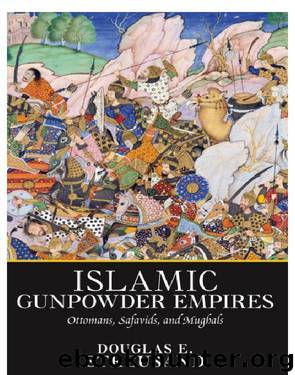Islamic Gunpowder Empires by Streusand Douglas E

Author:Streusand, Douglas E. [Streusand, Douglas E.]
Language: eng
Format: mobi, epub
Publisher: Westview Press
Published: 2010-09-30T21:00:00+00:00
IMAGE 4.3 Caravanserai at the Ganj ‘Ali Khan Complex (1598-1619), Kerman. Ganj Ali Khan served as Shah Abbas I’s governor of Kerman, Qandahar, and Sistan. A great patron of public works, Ali Khan’s most important commission was the complex in Kerman which included this magnificent double-storied caravanserai, a small mosque, public bathhouse, and three bazaars.
Like his politics, the commercial pattern created under Abbas continued after his death but gradually degenerated. Safi ended the silk monopoly, and the Armenians secured their dominance among the domestic merchants of the country. More silk was exported, via both the Gulf and the Levant; the EIC and the English Levant companies both benefited from the expansion. Holland, France, and Venice also purchased large amounts of Iranian silk. The East India companies continued to dominate the seaborne trade, and the EIC sought to establish a silk monopoly. This effort failed, but both the English and Dutch companies became extremely prominent in Iranian commerce. Their silk purchases were a vital source of income for the Safavid regime. The Dutch were more successful for most of the seventeenth century, owing to their victory in the First Anglo-Dutch War and use of military power to gain improved commercial terms. The French Compagnie des Indes was also active.
The peace on the Safavid frontiers for most of the seventeenth century stimulated trade in all directions. Trade with and through Russia grew considerably during the Safavid period. On the northeastern frontier, Mashhad became the major commercial center in the Safavid period; Qandahar likewise was the major entrepôt on the land route to India. Both routes remained active until the degeneration of public order in the early eighteenth century made trade difficult.
Abbas’s economic policy obviously strengthened his regime and made his political and military successes possible. From the perspective of the Iranian economy, however, his reforms’ effect was not entirely beneficial. In Amin Banani’s words, they were “structural manipulations to increase his immediate power and wealth. Compared with contemporary economic changes in Western Europe, Abbas’s reforms of the Persian economic structure lacked altogether the dynamic element of capital investment necessary for greater production.”16 By emphasizing the export of raw silk (not finished silk products), Abbas helped to move Iran into the passive role of exporter of raw materials and importer of finished products, mostly textiles. The obstacles to capitalist development were not of Abbas’s making or even limited to the Safavid period. The Safavids made few major alterations in the system of landholding that discouraged innovation and increases in production.
Download
Islamic Gunpowder Empires by Streusand Douglas E.epub
This site does not store any files on its server. We only index and link to content provided by other sites. Please contact the content providers to delete copyright contents if any and email us, we'll remove relevant links or contents immediately.
| Biological & Chemical | Conventional |
| Nuclear |
The Radium Girls by Kate Moore(11930)
100 Deadly Skills by Clint Emerson(4843)
Rise and Kill First by Ronen Bergman(4705)
The Templars by Dan Jones(4629)
The Doomsday Machine by Daniel Ellsberg(4420)
The Rape of Nanking by Iris Chang(4139)
Killing England by Bill O'Reilly(3953)
Hitler in Los Angeles by Steven J. Ross(3901)
Stalin by Stephen Kotkin(3880)
12 Strong by Doug Stanton(3509)
Hitler's Monsters by Eric Kurlander(3269)
Blood and Sand by Alex Von Tunzelmann(3140)
The Code Book by Simon Singh(3077)
Darkest Hour by Anthony McCarten(3072)
The Art of War Visualized by Jessica Hagy(2945)
Hitler's Flying Saucers: A Guide to German Flying Discs of the Second World War by Stevens Henry(2716)
Babylon's Ark by Lawrence Anthony(2622)
The Second World Wars by Victor Davis Hanson(2485)
Tobruk by Peter Fitzsimons(2446)
